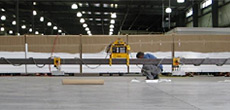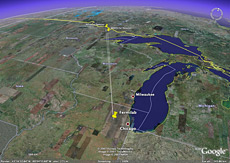| Tuesday, January 27, 2009 |
| Subscribe | Contact Fermilab Today | Archive | Classifieds |
NOvA experimenters busy in 2009NOvA experimenters will converge on the MINOS surface building at Fermilab this year as physicists use it as a testing ground for the design of their 15,000 ton detector before taking it underground in Minnesota. This next-generation neutrino project will send a beam of subatomic particles from Fermilab 450 miles underground to a detector in Minnesota. NOvA will test some of the most fundamental questions in particle physics: How did matter survive after the Big Bang, allowing for the formation of a matter-dominated universe? In essence, NOvA will delve into how the universe evolved by studying how neutrinos can toggle among different neutrino types during the subterranean trip from Fermilab to the Northern detector. NOvA also will study how the masses of those types are ordered in a hierarchy. NOvA is the only long-baseline, near-future experiment to study mass hierarchy. The results could give weight to a specific theory of unification – how the four fundamental forces of nature meld together at high energies, such as just after the Big Bang. Homing in on a specific unification theory would narrow the area physicists should search to look for physics beyond the Standard Model, the current understanding of particles and forces. But before researchers can test unification theories, they need to test quality, using three full-size prototypes of small sections of the mammoth detector. The work follows an approved long-term procurement and construction timeline. At the same time, Fermilab will upgrade the accelerator system for the new beam, and other collaborators from Fermilab and in Minnesota will ready the detector hall in Ash River, Minn., on the Canadian border. “There are a lot of things to work on, they just aren’t super visible,” said Project Manager John Cooper. “The scale of the detector means we have to break our prototyping into manageable chunks.” Currently, experimenters are building a large vacuum lifter and adhesive machine needed for construction this summer at Argonne of a full-size prototype of the detector's plastic structure, minus the scintillate, the material that detects the particle’s path. At Fermilab, collaborators will use a mini-prototype structure at the CZero building along the Tevatron ring to test the bottom seal under the full pressure of scintillate. A full-height prototype of one block of the detector – 31 planes glued together -- in the CDF assembly hall will test the stress resistance of the plastic and steel structure. By filling the PVC cell with liquid, experimenters can monitor how the cell bows with the pressure. By fall, experimenters should be able to move the prototype pieces from Argonne to a newly constructed interior hall in the MINOS building for sample data taking by fall 2010. Physicists hope to start taking data in Minnesota by July 2012. --Tona Kunz |

